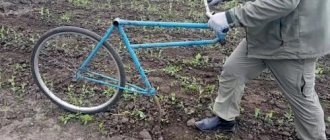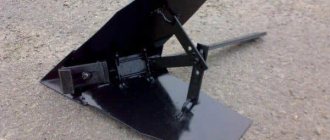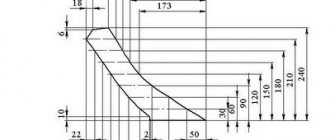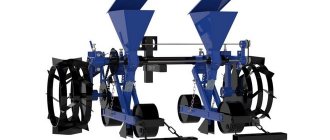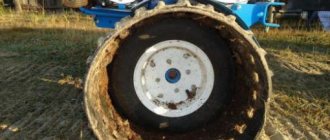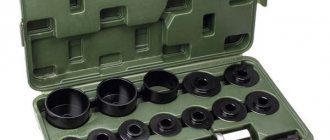Options for power distribution mechanisms
Structurally, the simplest way to solve the problem arising from the rigid connection of the wheels is to use overrunning clutches, which allow the wheel to rotate faster than the axle driving it.
Overrunning clutches
This mechanism is well known in all its variations: both with a ratcheting mechanism (bicycle wheel hub) and with wedging rollers (electric starter bendix).
Overrunning clutches are also used in the power drive of a number of cars with plug-in axles. However, this solution has a characteristic feature: when cornering, the overrunning clutch is disconnected on the wheel running along the outer radius, as it tends to rotate faster than the drive shaft.
To make it easier to enter a turn, on the contrary, most of the torque should be transmitted to it.
This problem is solved in the classic gear differential , which distributes power in inverse proportion to the rotational resistance of the wheels.
But it is also noticeably more difficult to produce, and also requires forced full or partial blocking on off-road conditions, since otherwise it redistributes all the power to the slipping wheel.
Need for differential
Many works performed with a walk-behind tractor (for example, cultivation) require its linear movement . In this case, a rigid drive on both wheels works great, significantly reducing the cost and simplifying the walk-behind tractor.
If frequent sharp turns are necessary, a walk-behind tractor of this type will require significant physical effort - one of the wheels will be braked by lugs, and the walk-behind tractor will have to tilt, hanging the outer wheel in the air.
This is especially difficult if the walk-behind tractor has a wide track and is quite heavy.
How to make a homemade differential for a walk-behind tractor with your own hands - drawings
How to make a differential for a walk-behind tractor with your own hands? As a rule, the operation of a walk-behind tractor does not require long-term rotation of the wheel relative to the drive axis.
Due to this, often called “semi-differential” schemes are common, which provide the ability to freely rotate the wheel relative to the axis at a certain angle.
For more information about the “semi-differential”, watch the video:
The simplest mechanism in this case looks like a bushing with a transverse slot attached to the axis of the walk-behind tractor. A short axle is inserted inside this bushing, secured from falling out by a bolt wrapped into its body through a slot, and the wheel is attached directly to the axle.
In this case, when the walk-behind tractor moves, the drive axle rotates the bushing freely until the rear edge of the slot rests against the bolt, and then transmits torque to the axle through it.
Soil cultivation is one of the main agrotechnical activities, which is a mandatory part of the annual soil cultivation regime. By clicking on the link, you will get acquainted with the convenient and practical Loplosh cultivator.
A snowmobile allows you to quickly and comfortably move through the snow from one point to another, while also carrying a passenger or some kind of cargo. Here is the lineup and prices of 2016 Yamaha snowmobiles.
The quality of the grown products, its productivity, and, ultimately, the return on financial and physical investments depend on the timely and high-quality use of special means when growing crops. Here you will learn how to make a sprayer with your own hands.
During a turn, the wheel, trying to overtake the drive, moves the bolt forward along the slot, breaking the transmission of torque, and the angle of easy rotation of the walk-behind tractor depends on the length of the slot.
Such extension cords are extremely simple and can be made by unskilled machine operators, and therefore are cheap and widespread. They are usually made with several additional holes, allowing you to vary the track width of the walk-behind tractor and rigidly connect the wheel to the drive axle if necessary.
Drawings of these homemade differentials are widely distributed on the Internet.
The disadvantage of the described design is the relatively small possible angle of free rotation of the wheel (no more than 240 degrees), since the transverse groove greatly reduces the overall strength of the mechanism, and high internal friction, especially when dirt inevitably gets inside the bushing.
Most often, extension cords with free movement are used on light walk-behind tractors, like the Niva.
Do-it-yourself walk-behind tractor from A to Z
Those who have to cultivate large areas of land simply cannot do without the help of special equipment. Of course, you can only use improvised means, but is it worth your own health? And a lot of time is spent on digging, loosening and weeding the beds.
Today there are a lot of auxiliary equipment on the market that anyone can purchase. The most popular are walk-behind tractors. They cope with many tasks: from digging, planting, weeding and ending with snow removal in winter.
But what to do if your financial situation does not allow you to purchase this assistant at the moment? There is only one way out: create a walk-behind tractor with your own hands, especially since it is not so difficult!
3 reasons to create a walk-behind tractor with your own hands
So you:
- save a significant amount of money, because most of the consumables can be found on your farm (for example, in old chainsaws, motorcycles, mopeds or agricultural machinery);
- make a walk-behind tractor with your own hands, which will be designed to suit your needs and will be convenient for you;
- save on equipment repairs. You make the walk-behind tractor yourself, which means you know its design perfectly. Hence the conclusion: if it breaks down, there is no need to take it to the workshop.
By the way, as an option, we can offer you another advantage of creating a walk-behind tractor with your own hands. But let's say right away: it is not for everyone, but only for those who really live by design. Having mastered and studied the intricacies of the process of making a walk-behind tractor with your own hands, if you wish, you can make equipment for sale, thus building your own mini-business. Well, why not? Your neighbors in the garden or your family and friends will probably want to buy the same assistant as yours, saving a good amount.
Go to the section of spare parts for walk-behind tractors
DIY walk-behind tractor frame
All parts of a homemade walk-behind tractor are located on one frame. That is why special attention should be paid to the manufacture of this part of the equipment. The steering wheel with control levers can be removed, for example, from the Izh motorcycle. All that remains is to weld it to the rear ends of the side members, which, by the way, are best made from a steel water pipe. An inch and a quarter diameter will be sufficient. By the way, the ends of the side members should be bent upward, and in the rear part they should also be counter-connected by welding.
Weld the cross member along the side members. It will become a stop for the chain tensioner of the first stage of the transmission. You also need to provide:
- platform and bracket on which the battery is mounted;
- second stage chain drive housing;
- bracket for attaching a cultivator subframe (or a biaxial trolley).
A milled channel No. 8 can serve as a bracket for attaching the cultivator subframe, and an M10 bolt can serve as a tensioner for the first stage power transmission chain.
DIY walk-behind tractor engine
It’s worth mentioning right away that the operating principle of a scooter/motorcycle engine, from which the motor is usually removed, is slightly different from the operating principle of a walk-behind tractor. That is why it will have to be optimized a little. First of all, it is worth determining the engine cooling system. If it is passive air, you need to convert it to active. To save fuel, increase traction and make starting easier, it is worth replacing the valve with a reed valve.
The best engine option for a homemade walk-behind tractor will be a two-stroke gasoline 13-horsepower engine. It can be removed from the Ant scooter. The choice fell on this model, because it already has forced air cooling of the engine. In this case, your walk-behind tractor will avoid overheating at low speeds, which means it will serve for a long time without breakdowns. Experts also recommend considering the option of installing the engine from the IZH-Planet-3 motorcycle. It has 18 horsepower, which will increase the productivity of equipment.
If you nevertheless choose an engine from the Ant cargo scooter for your walk-behind tractor, keep in mind that it contains:
- The 4-speed gearbox is interlocked with the engine;
- You will most likely have to make the muffler yourself. You will need a steel pipe filled with metal shavings, 250 mm long and 70 mm in diameter. If you don’t want to tinker with it, you can buy a ready-made muffler for a walk-behind tractor. Its price is quite affordable.
If the choice falls on the motor from IZH-Planet-3, then the gearbox will still have to be taken from the Ant scooter. It will be necessary to remove the satellite differential cups, and their windows will need to be widened.
In the place where the motor will be located on the frame of the walk-behind tractor, there should be a slide with an arc welded to the crossbars. It can be made from a water pipe with a diameter of 42 mm. Bracket brackets must be welded in the center and at the ends of this arc.
Do-it-yourself walk-behind tractor chain reducer
The gearbox is one of the main parts of the walk-behind tractor. It is designed to reduce rotation and increase torque, which is transmitted from the output shaft of the unit to the wheels. You can also take it from the Ant scooter. Install the gearbox on the walk-behind tractor between the engine and the wheels. But this is only if the equipment is not equipped with attachments that require power to be transferred to it. We are talking about cutters, drills, snow blowers, etc. In this case, you should make sure that the gearbox transmits torque to this particular equipment.
General Tips
Let's start with the simplest option in the form of an axle extension with a transverse groove . It will be quite reliable even if made from affordable mild steel.
Axle extension
It is better to use a bolt connecting the components of the extension with an internal hexagon head and mill a groove with a width equal to its outer diameter.
In this case, firstly, there are no protruding parts capable of wrapping grass around itself, and secondly, a bolt tightened all the way will not become loose over time.
The gap between the bushing and the extension axle cannot be made too small , since if corrosion occurs they will become acidic to each other. It is highly advisable to place a grease fitting on the bushing for in-place lubrication of the structure.
The more complex rotary hub design can also be made from mild steel as it is easily welded.
Finishing of the bearing holes in the hub must be done after the flange and rotation angle limiter are welded due to the inevitable warping of the part during welding.
Making a differential for a walk-behind tractor yourself cannot be called a technically difficult task, and this is proven both by the experience of many owners of garden equipment and by the fact that common offers in online stores copy originally handicraft designs.
The invested labor costs will quickly pay off by facilitating the operation of the walk-behind tractor.
General recommendations
Here are some tips for farmers on how to assemble an excellent homemade differential for a walk-behind tractor:
- The gap between the extension axle and the bushing cannot remain too small. If the corrosion process begins, they will “stick” to each other;
- To lubricate the agricultural device without preliminary disassembly, it is a good idea to place a grease nipple on the bushing;
- Extensions can be constructed from low carbon steel. The unit will be strong, reliable, and at the same time quite inexpensive in cost.
How to make a differential for a walk-behind tractor with your own hands
Motorized cultivators have recently been in great demand among agricultural workers. As for the differential for a walk-behind tractor, it is an integral part of the design of the vehicle’s power drive. This is an element with several wheels that are located on the same axis. Despite the fact that initially this part may seem quite complicated, it is not only easy to repair, but you can make a differential for a walk-behind tractor with your own hands. There are many diagrams and drawings that are successfully used by both specialists and beginners in this matter.
How to make a differential for a walk-behind tractor
Modern special equipment has made it possible to take agriculture to a new level. Currently, there is no need to cultivate the land manually, since auxiliary equipment exists for this. However, like other specialized devices, this type of equipment such as a walk-behind tractor does not last forever, which is why these devices have to be repaired in a timely manner. Often the load distribution system fails.
A differential for a walk-behind tractor is a device that allows you to evenly distribute power between the wheels. Due to constant heavy load, the device may fail, which requires timely replacement.
You can make a differential for a walk-behind tractor yourself
Purpose of this element
Before you familiarize yourself in detail with the varieties, manufacturing options and mounting method, you need to consider why a differential is installed on a walk-behind tractor, namely:
- The main function of this device is to distribute power between the wheels of special equipment.
- At the moment of rotation of the wheel relative to the axis, this mechanism does not allow the element passing along a smaller radius to slip.
- A load is regularly placed on the differentials, provided that rotation of the wheels is created relative to the axis in a different projection (when cornering).
- The device allows you to process a relatively large mass (the load that appears when the direction of the axis changes).
In other words, if special equipment or other vehicles are not equipped with these mechanisms, then when turning, a significantly greater load will be placed on one side, which will entail a gradual failure of the entire suspension.
Important! Due to their fairly simple design, differentials for a walk-behind tractor can be made independently, but here it is first necessary to create an appropriate diagram of this element.
In this video you will learn how to make a differential for a walk-behind tractor:
It is recommended to assemble and install a device such as a differential for a walk-behind tractor, provided that you have the appropriate education and experience. If you lack skills in this matter, then you can always contact our company, where qualified employees will be ready to undertake the manufacture and installation of the device on special equipment. All work is done quickly, reliably and efficiently. At the same time, we charge a modest fee for our services.
Why does a walk-behind tractor need this element?
The walk-behind tractor wheel, which follows an outer arc when turning, must travel a longer distance. And here the need arises for a differential or other mechanism for distributing power, which will avoid slipping. If the wheel device does not have this element, this will cause straightening of the movement. Moreover, the greater the distance between the wheels, the more difficult it will be to turn.
The main part of the work that is carried out on the ground, for example, cultivation or fertilization, is carried out in a straight line. But this does not mean that the device will never turn. Of course, the standard version of a walk-behind tractor with a rigid 2-wheel drive makes it quite convenient to use in most agricultural work. But if frequent turns are necessary, the problem with slippage and control will have to be additionally solved. If special mechanisms are not used, the vehicle will be braked by lugs. Such work will be difficult even for a person with great physical strength.
Most often, experts choose to use overrunning clutches as a solution to this issue.
These are simple and universal installations that allow you to correctly distribute the load between the wheels if you need to turn the walk-behind tractor. The versatility of this method lies in the fact that overrunning clutches can be used not only on a rigid axle, but also on a connected one. In this case, when turning, the wheel will tend to rotate faster than the front shaft. This makes it possible to conveniently operate the machine and work even in small areas, as the device becomes more maneuverable.
DIY differential for walk-behind tractor
› Motoblocks
Motorized cultivators have recently been in great demand among agricultural workers. As for the differential for a walk-behind tractor, it is an integral part of the design of the vehicle’s power drive. This is an element with several wheels that are located on the same axis. Despite the fact that initially this part may seem quite complicated, it is not only easy to repair, but you can make a differential for a walk-behind tractor with your own hands. There are many diagrams and drawings that are successfully used by both specialists and beginners in this matter.
Why does a walk-behind tractor need this element?
The walk-behind tractor wheel, which follows an outer arc when turning, must travel a longer distance. And here the need arises for a differential or other mechanism for distributing power, which will avoid slipping. If the wheel device does not have this element, this will cause straightening of the movement. Moreover, the greater the distance between the wheels, the more difficult it will be to turn.
The main part of the work that is carried out on the ground, for example, cultivation or fertilization, is carried out in a straight line. But this does not mean that the device will never turn.
Of course, the standard version of a walk-behind tractor with a rigid 2-wheel drive makes it quite convenient to use in most agricultural work. But if frequent turns are necessary, the problem with slippage and control will have to be additionally solved.
If special mechanisms are not used, the vehicle will be braked by lugs. Such work will be difficult even for a person with great physical strength.
Most often, experts choose to use overrunning clutches as a solution to this issue.
These are simple and universal installations that allow you to correctly distribute the load between the wheels if you need to turn the walk-behind tractor. The versatility of this method lies in the fact that overrunning clutches can be used not only on a rigid axle, but also on a connected one. In this case, when turning, the wheel will tend to rotate faster than the front shaft. This makes it possible to conveniently operate the machine and work even in small areas, as the device becomes more maneuverable.
Simple design for a walk-behind tractor
Many farmers, when using conventional equipment, often think about how to make a differential for a walk-behind tractor with their own hands. A similar idea may come to a repairman if an old element breaks down. There are no particular difficulties in making a differential for a walk-behind tractor with your own hands. But first, you should stock up on a suitable diagram or prepare drawings.
Those who are thinking about what type of differential to choose for a walk-behind tractor should remember that this type of equipment does not require prolonged rotation of the wheels relative to the axis. That is why you can choose the simplest options.
Often, universal differential systems are used for walk-behind tractors. They allow the wheels to deviate from the axis by a certain degree.
In the simplest version, you need to take a bushing with a transverse slot and insert a short axle into it. The last element must be fixed with a bolt, and only then attached to the wheel structure. This system works quite simply. The drive axle must turn the bushing all the way, that is, until it hits the bolt. It is worth noting that with this element the master can initially set the most suitable wheel rotation angle for him, which also depends on the size of the slot.
The peculiarity of this detail is its maximum simplicity. You don’t have to be an experienced craftsman or mechanic to make such a differential for your walk-behind tractor. You just need to have certain skills in operating a machine. This will be enough to obtain the basic elements needed to make such a differential.
Advantages and disadvantages
The main advantage of this method of solving the problem of turning wheels is the simplicity of the design. In addition, such a differential is universal, as it is suitable for almost all types of walk-behind tractors.
But the semi-differential also has its disadvantages. Here, first of all, you need to note the small angle of rotation that will be available after installing such a structure. This type of mechanism does not allow rotation of more than 240º. Many farmers note that the presence of a transverse groove makes the structure not very strong. If the load is significant, the axle may break. Therefore, those who decide to use their own made differentials for a walk-behind tractor should be prepared for the fact that the structure will periodically have to be repaired and remodeled.
Simple design for a walk-behind tractor
Many farmers, when using conventional equipment, often think about how to make a differential for a walk-behind tractor with their own hands. A similar idea may come to a repairman if an old element breaks down. There are no particular difficulties in making a differential for a walk-behind tractor with your own hands. But first, you should stock up on a suitable diagram or prepare drawings.
Those who are thinking about what type of differential to choose for a walk-behind tractor should remember that this type of equipment does not require prolonged rotation of the wheels relative to the axis. That is why you can choose the simplest options.
Often, universal differential systems are used for walk-behind tractors. They allow the wheels to deviate from the axis by a certain degree.
In the simplest version, you need to take a bushing with a transverse slot and insert a short axle into it. The last element must be fixed with a bolt, and only then attached to the wheel structure. This system works quite simply. The drive axle must turn the bushing all the way, that is, until it hits the bolt. It is worth noting that with this element the master can initially set the most suitable wheel rotation angle for him, which also depends on the size of the slot.
Purpose of this element
Before you familiarize yourself in detail with the varieties, manufacturing options and mounting method, you need to consider why a differential is installed on a walk-behind tractor, namely:
- The main function of this device is to distribute power between the wheels of special equipment.
- At the moment of rotation of the wheel relative to the axis, this mechanism does not allow the element passing along a smaller radius to slip.
- A load is regularly placed on the differentials, provided that rotation of the wheels is created relative to the axis in a different projection (when cornering).
- The device allows you to process a relatively large mass (the load that appears when the direction of the axis changes).
In other words, if special equipment or other vehicles are not equipped with these mechanisms, then when turning, a significantly greater load will be placed on one side, which will entail a gradual failure of the entire suspension.
Important! Due to their fairly simple design, differentials for a walk-behind tractor can be made independently, but here it is first necessary to create an appropriate diagram of this element.
In this video you will learn how to make a differential for a walk-behind tractor: It is recommended to assemble and install a device such as a differential for a walk-behind tractor, provided that you have the appropriate education and experience. If you lack skills in this matter, then you can always contact our company, where qualified employees will be ready to undertake the manufacture and installation of the device on special equipment. All work is done quickly, reliably and efficiently. At the same time, we charge a modest fee for our services.
Advantages and disadvantages
The main advantage of this method of solving the problem of turning wheels is the simplicity of the design. In addition, such a differential is universal, as it is suitable for almost all types of walk-behind tractors.
But the semi-differential also has its disadvantages. Here, first of all, you need to note the small angle of rotation that will be available after installing such a structure. This type of mechanism does not allow rotation of more than 240º. Many farmers note that the presence of a transverse groove makes the structure not very strong. If the load is significant, the axle may break. Therefore, those who decide to use their own made differentials for a walk-behind tractor should be prepared for the fact that the structure will periodically have to be repaired and remodeled.
Considering all the pros and cons, we can say that for those who are not too demanding of their walk-behind tractor and lightly load it with straight and rotary work, a semi-differential is perfect. For serious loads, it is worth looking for more durable structures.
Differential for a walk-behind tractor - how it works and what it’s capable of
Diary entry created by user CaimanTeh, 02/26/15 .723,
Recently, a video of the Caiman Vario walk-behind tractor with a snow thrower attachment was posted on YouTube. During the story about the features of winter use of the walk-behind tractor, “additional differentials” installed on the wheels were mentioned.
To demonstrate the differentials, Denis turned the walk-behind tractor back and forth. The demonstration was short, but this option interested the participants in the Pubert & Caiman Motor Tillers
In the topic, it seemed like they quickly figured out what these additional differentials were for a walk-behind tractor, but since the question arose, I decided to make a short photo report. After filming, the demonstration walk-behind tractor with a differential was full of gasoline and oil, so it was taken to the service room. It's cramped there, there's a lot of other equipment around, so we couldn't spin it. All I got from Caiman Vario was a photograph.
Differential for Caiman Vario walk-behind tractor
So, here are these differentials, or rather semi-differentials installed together with standard rubber wheels of size 4.00-8. (The set of two semi-differentials is called “Differentials with extensions for the VARIO/Q Junuor/Q Max walk-behind tractor” and has code R0101.)
How it's done
The design of such differentials for walk-behind tractors (and walk-behind cultivators, by the way) is extremely simple:
- the wheel hub is not secured to the axle
- there are protrusions on the axle and hub (indicated by green arrows) that prevent the wheel from turning a full turn
How it works
During normal movement of the walk-behind tractor, the protrusion on the axle rests against the protrusion on the hub and transmits rotation to the wheel. In this case, both wheels will rotate simultaneously.
But if you push the walk-behind tractor forward, the differential hubs will work as overrunning clutches, and the protrusions on the wheels will “run away” from the protrusions on the axle. They won’t be able to run far - having made almost a full turn, the protrusion on the hub will touch the protrusion on the axle, but this will be enough to complete the maneuver.
After completing the turn, the walk-behind tractor with the differential will be able to move only at the expense of one wheel until the protrusion on the axle of the second wheel “catch up” with the protrusion on the hub. It is also possible to slip one wheel until the “unlocked” one comes into working condition.
Why do we need differentials for a walk-behind tractor?
To put it simply, the walk-behind tractor needs differentials to turn at the end of the furrow. This is how the same Caiman Vario turns around on lugs and without differentials.
To turn the walk-behind tractor and return to the cultivated area, the lugs have to be dragged along the ground. And here it all depends on the weight of the walk-behind tractor (or cultivator) and the strength of the operator.
At the end there will be a video showing how much differentials make this task easier.
Differentials on the Pubert Quatro Junior walk-behind tractor
Above was a picture with a differential hub different from that installed on the Caiman Vario - in the showroom there was another walk-behind tractor with a similar design of differentials.
Differentials on the Pubert Quatro Junior walk-behind tractor
Unlike previous domestic differentials suitable for several models, these are part of the native French “Plowing Kit” (code 8000010205) for the Quatro Junior and QJ V2 models (Caiman, Pubert and MasterYard, including models with a diesel engine) which includes includes:
- differentials
- wheels 5.00-10
- weights
- reversible plow
Quatro Junior with this kit has a wide track and weighs over 100 kg. In order to turn it around with its wheels locked, you need to be either very strong or very stubborn. In any case, such a turn at the end of each furrow will take a lot of time and effort in total.
Being roughly in the same weight category with walk-behind tractors, I decided to fight him. To do this, I rolled it out into the open area of the showroom.
Testing the capabilities of differentials on a walk-behind tractor
I filmed the testing. There were several tests, one of them was caught on video. The video clearly shows how the wheels rotate during a turn.
The maximum rotation angle is 270 degrees (3/4 turn), the minimum is 180 degrees (1/2 turn). In real work, it is better to rely on the minimum value. A 270-degree turn turned out to be possible due to the artificiality of the situation and the pushing of the walk-behind tractor back and forth. Although, in real life, a 3/4 turn is possible.
The rubber wheels squeak terribly on the marble when turning, and when locked they do not move at all. This can be seen in the video at the beginning and end of the spread. Attempts to move this hundredweight with locked wheels led to nothing.
How to make a differential for a walk-behind tractor with your own hands - we describe it in order
The walk-behind tractor is a very useful and multifunctional equipment that greatly simplifies the life and work of its owners. For even more productive and economical use of its power resources, many devices and attachments have been created. Such devices also include the differential and hub. We will tell you about their main functions, capabilities and how to independently manufacture such parts in this article.
Types of power distribution mechanisms
Structurally, the simplest way to solve the problem arising from the rigid connection of the wheels is to use overrunning clutches, which allow the wheel to rotate faster than the axle driving it.
This mechanism is well known in all its variations: both with a ratcheting mechanism (bicycle wheel hub) and with wedging rollers (electric starter bendix).
Overrunning clutches are also used in the power drive of a number of cars with plug-in axles. However, this solution has a characteristic feature: when cornering, the overrunning clutch is disconnected on the wheel running along the outer radius, as it tends to rotate faster than the drive shaft.
To make it easier to enter a turn, on the contrary, most of the torque should be transmitted to it.
This problem is solved in the classic gear differential , which distributes power in inverse proportion to the rotational resistance of the wheels.
But it is also noticeably more difficult to produce, and also requires forced full or partial blocking on off-road conditions, since otherwise it redistributes all the power to the slipping wheel.
Design and purpose of a walk-behind tractor differential
The main purpose of the walk-behind tractor differential is to distribute power more evenly between the wheels of the walk-behind tractor.
The differential will be especially useful when turning. To turn a walk-behind tractor, you usually need to put in a lot of effort, especially if the equipment has lugs and attachments. The differential allows for easier turning due to faster wheel rotation. Thanks to it, the wheels rotate faster than the one that occurs only due to the axle. For different models of walk-behind tractors, differentials have their own design features and differences. For example, for light Neva walk-behind tractors, differentials with a small wheel rotation angle (240°) are used. Also, due to the transverse groove, it has little strength; strong friction of the parts is observed inside the mechanism.
Motoblocks from Salut are equipped with differentials of a more complex design. They are distinguished by greater mass and wheel rotation angle (about 330°). The extension has bearings, which reduces the effort when turning.
For Farmer brand walk-behind tractors, differentials consist of two clutches, and control is carried out using levers on the steering wheel.
Differential, hubs for a walk-behind tractor - do it yourself, types, video
A differential for a walk-behind tractor is an integral part of the power drive of an agricultural machine, which moves using several wheels mounted on one axis. The main function of the differential is to accurately distribute engine power between the wheels of the walk-behind tractor. It is the presence of this mechanism that gives the unit the ability to take turns smoothly, without jerking or skidding.
How to make a differential for a walk-behind tractor with your own hands?
Despite the fact that the differential for the walk-behind tractor has a rather simple design, before making it yourself you will need to prepare and study the drawings. They should indicate the dimensions of the mechanism spare parts and methods of fixing them in the device.
Practice shows that every homemade differential has a small rotation angle of the wheels in the free position. As a rule, this parameter does not exceed 250 °. This disadvantage is due to the fact that the design of the mechanism includes a transverse groove, which significantly reduces the power and efficiency of the design. Another significant disadvantage is the rapid wear of the parts of a homemade differential, especially if a large amount of dirt accumulates between them. In this regard, self-made differentials should be used for exceptionally light models of walk-behind tractors.
In order for a homemade differential to be more durable and effective, you should adhere to a number of rules:
- there is no need to leave too small a groove in the space between the bushing and the extension axle. If corrosion occurs, these parts will quickly stick to each other;
- in order to timely lubricate the differential without regularly disassembling it, you need to place a pressing oiler on the mechanism bushing;
- For the manufacture of extension cords, it is best to use carbon steel. As a result, the mechanism will be more reliable and, at the same time, not expensive. The video will tell you more about making the differential.
Making a differential for a walk-behind tractor is not a complicated procedure. By following all the recommendations listed, you will be able to assemble a durable mechanism that will quickly pay for itself with further use.
Types and characteristics of hubs for walk-behind tractors
The hub for a walk-behind tractor is an important element of the design of an agricultural machine. Its presence, paired with an installed special attachment, significantly improves the quality of plowing the soil, hilling beds, planting potatoes, harvesting and other activities in the garden.
There are two types of hubs on sale.
Among them stands out:
- differential hub - this part is considered universal and can be mounted on all walk-behind tractors, regardless of their class and design features. Differential hubs are required for use on those walk-behind tractors whose factory equipment does not include a wheel unlocking mechanism, as well as for those models of equipment that cannot be freely deployed at the end of the cultivated bed. This walk-behind tractor wheel hub is equipped with bearings, which significantly increases the maneuverability of the unit:
- ordinary hub - a part of this type has a simpler design, but is less efficient in use. It only slightly improves the maneuverability of the walk-behind tractor, so every year it is in less and less demand among farmers.
Differential hubs, or semi differentials as they are also called, consist of one or a pair of bearings, as well as retainers. When using such a part, in order to turn the walk-behind tractor, it is necessary to disconnect the lock from the corresponding latch.
Depending on their diameter and shape, differential hubs for walk-behind tractors can be of the following types:
- round hub;
- sliding part;
- hexagonal hub - can have a diameter of 24 or 32 mm.
Need for differential
Many works performed with a walk-behind tractor (for example, cultivation) require its linear movement . In this case, a rigid drive on both wheels works great, significantly reducing the cost and simplifying the walk-behind tractor.
If frequent sharp turns are necessary, a walk-behind tractor of this type will require significant physical effort - one of the wheels will be braked by lugs, and the walk-behind tractor will have to tilt, hanging the outer wheel in the air.
This is especially difficult if the walk-behind tractor has a wide track and is quite heavy.
How to make a differential for a walk-behind tractor with your own hands?
To avoid unnecessary financial costs, you can make a homemade differential. This process is not complicated, and the availability of freely available drawings and various materials makes the task even easier.
The manufacturing process looks like this:
- using a lathe, a part is turned according to the drawings;
- the flange is turned out and carefully welded to a part of the metal pipe;
- To make a differential, use only high-quality steel blanks, since this part is subject to high loads.
Making a hub - step-by-step algorithm
As in the case of a differential, to manufacture a hub for a walk-behind tractor, you will need to prepare drawings. A detailed diagram will make it possible to complete the work faster and avoid common mistakes.
The correct sequence of actions when making a hub is as follows:
- First you need to grind the workpiece. To do this, any metal part is taken and processed on a lathe;
- A fairly popular option is to make a flange and then weld it to a metal pipe or rod. When processing a part, you should be extremely careful and observe the dimensions indicated in the selected drawings;
- It should be remembered that during operation the hub will be subject to constant loads, which is why it is better to choose a reliable material for making it yourself - for example, hardened steel.
After manufacturing the hub, it can be installed on the walk-behind tractor and tested in operation.
You should not place high loads on the part immediately after installing it on the unit - otherwise it may become deformed. It is best to walk with the walk-behind tractor several times on a flat surface in the yard, turning the car around several times. After this, the hub will finally fall into place, and the unit with it can be used for work in the garden. A self-made differential or hub can be successfully used to equip Neva brand walk-behind tractors. The design of the units of this brand allows you to easily install the part, and, if necessary, remove it easily and quickly.
Characteristics and types of hubs for walk-behind tractors
A hub for a walk-behind tractor is needed to install pneumatic wheels or steel lugs.
Walk-behind tractor wheel hubs come in 3 main types:
- differential hub with unlocking;
- semi-differential hub (simplified version of the previous one);
- the hub is ordinary.
A differential hub for a walk-behind tractor is considered a universal part and is needed in cases where the walk-behind tractor is not equipped with a wheel unlocking system, and turning the vehicle around causes difficulties. The hub with bearings greatly facilitates control and improves maneuverability. To perform a turn, you just need to remove the lock from the lock of the required wheel.
Based on the diameter of the hub, they are classified into:
- hexagonal (24 and 32 mm);
- round.
Hub for walk-behind tractor with differential
The hub for a walk-behind tractor is the main component when operating such equipment. It is designed for attaching attachments to a walk-behind tractor intended for performing agronomic manipulations.
The hub can be used to attach equipment such as pneumatic wheels.
There are two types of hubs:
- ordinary;
- hub with differential.
It is generally accepted that the differential hub is universal for all types of walk-behind tractors. It makes it possible to simplify the maneuvers of equipment and is suitable for both a cart and a walk-behind tractor. The differential hub consists of a retainer and several bearings. To perform the turning maneuver, you just need to unlock the required lock. The hub with bearings is used for the walk-behind tractor and is universal for all walk-behind agricultural machinery. When using a hub with a differential, you will make your life easier and improve the functionality of the walk-behind tractor, thereby extending its service life.
Walk-behind tractors with wheels are standardly equipped with these elements, but it is not very convenient to remove them every time when it is necessary to attach attachments. Therefore, it is logical to get another pair. This will save your time and reduce wear on the main elements. Below you can see a diagram of how to make hubs for a walk-behind tractor with your own hands.
Self-production of a hub for a walk-behind tractor
As already mentioned, there are different options for the design of hubs for walk-behind tractors. To make the simplest version, you can use the following drawing:
The main thing to remember when making your own is to follow safety precautions and use high-quality materials for a longer service life of the part.
We also invite you to watch a detailed video that describes the intricacies of making a homemade hub for a walk-behind tractor:
Hubs for a walk-behind tractor: how to make it yourself?
The need for these devices for a walk-behind tractor is undeniable. Different types of such structural elements are used for motorcycles. They can be purchased on the walk-behind tractor market or made by yourself. This process will not be difficult if you follow the instructions exactly. It’s easy enough to make a hub for a walk-behind tractor with your own hands using the following drawing.
When making a part by hand, it is best to use the highest quality materials. There is a need for the element to be durable, since it bears a large load during operation.
